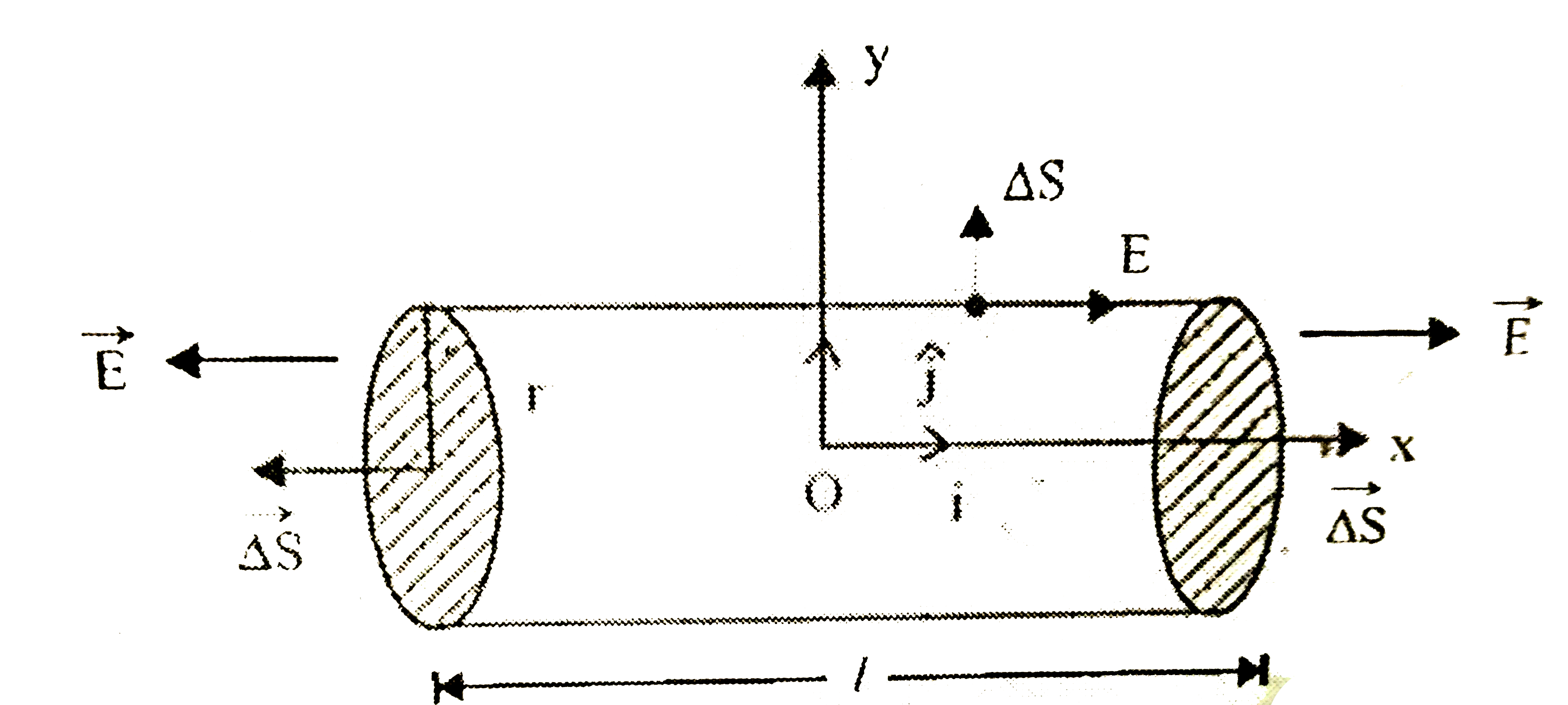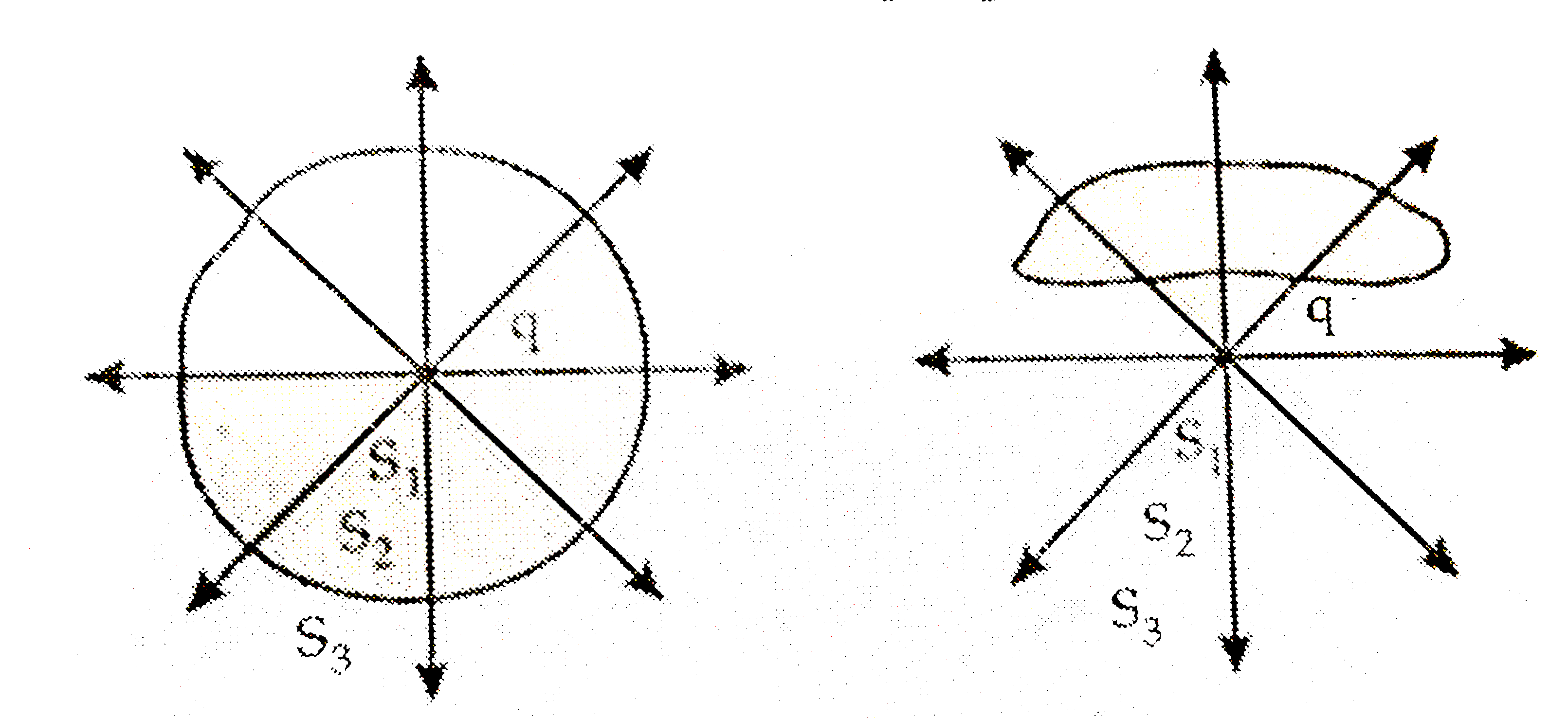(a) define electrie flux. Write its, S.I unit.
" Gauses'[s law in electrostatis is true for any closed surface, no matter what its shape or size is.
Justify this statement with the help of a suitable example.
(b) Use Gauss's law to prove that the electric field inside a uniformly charged spherical shell is zero.

OR
(a) Derive the expression for the energy stored ina parallel plate capactor. Hence obtain the expresion for the energy density of the electric field.
(b) A fully charged parallel plate capacitor is connected across an ucharged identical capacitor. Show that the energy stored in the combination is less than that stored initially in the single capacitor.
(a) we can see from the figure that →Enad−−−→△S are parallel. Therefore, the outward flux is
ϕL=→E.−−−→△S=−Exˆi−.△S=Ex△S
=Exπr2NM2C−1
on the right, face, →Eand−−−→△S are parallel
ϕR=→E.−−−→△S=Exπr2Nm2C−1
for any point of th side of cylinder, →E is perpendicular to △S.
→E.−−→ES=0
therefore, the flux out of the cylinder is zero.
Thus, net outward flux through the cylinder is .
ϕ=Exπr2+Exπr2+0=2Exπr2Nm2C−1
The net charge within the cylinder can be found by using Gauss's law, which given
q=E0ϕ
(b) The electric flux through a closed surface is proportional to the charge contained inside the surface.

The strength of the electric field every where on this sphere is
∣∣→E∣∣=Keqr2
Since every point on the sphere's surface is a distance r from the charge.
ϕE=∣∣→E∣∣A=keqr2(4πr2)=4πkeq
pemrmittivity of free space : e0=14πε0=8.85×10−12C2N.m2
Gauss's law in electric flux ϕE through any closed surface is equal to the net charge inside the surface, Qinside divided by ε0
ϕE=Qinsideε0
OR
Energy stored in a parallel plate capacitor : work is done in charging a capacitor. This work done is stored as its electrical energy. Suppose a capacitor is charged with charge q show that potential diffence between its plates is
V=qC
Work done to increase the charge by an around dq is dW−Vdq=qcdp
Total work done to change the capacitor from 0 to Q is W=Qf0qcdq=1c[q22]Qf0=Q22C
Energy of the capacitor , U=12Q22C=12QV [∵C=QV]
(i) Here K=∈r=10beacuseC=∈0Ad
C1=K∈0Ad/2=10×2×∈0Ad=20C
Capacitance becomes 20 times.
(ii) Electric field between the plates remains unchanged (E1−E) because the p.d. across the plates remains unchanged.
(iii) U=12CV2∴U1=12C1V2=12(20C)V2=20(12CV2)=20U
Energy stored increases 20 times.
Topper's Solved these Questions
- XII BOARDSBOOK - XII BOARDS PREVIOUS YEARCHAPTER - XII BOARDSEXERCISE - SECTION-A
31 Videos
- XII BOARDSBOOK - XII BOARDS PREVIOUS YEARCHAPTER - XII BOARDSEXERCISE - SECTION-B
65 Videos
- XII BOARDSBOOK - XII BOARDS PREVIOUS YEARCHAPTER - XII BOARDSEXERCISE - section -D
3 Videos
- SAMPLE PAPER 2019BOOK - XII BOARDS PREVIOUS YEARCHAPTER - SAMPLE PAPER 2019EXERCISE - SECTION D
6 Videos
Similar Questions
Define electric flux. Write its SI unit.
"Gauss 'law in electrostatic is true for any closed surface, no matter what its shape or size is" Justify this statement with the help of a suitable example.
View SolutionAssertion (A) : The electric field at any point inside a uniformally charged thin spherical shell is zero.
Reason ® : Entire charge given to a thin spherical shll lies only on its outer surface and there is no charge present inside the shell.
View Solution
Knowledge Check
Assertion : Total flux through a closed surface is zero if no charge is enclosed by the surface.
Reason : Gauss law is true for any closed surface, no matter what its shape or size is.AIf both assertion and reason are true and reason is the correct explanation of assertion.BIf both assertion and reason are true but reason is not the correct explanation of assertion.CIf assertion is true but reason is false.DIf both assertion and reason are false.
Using Gauss's theorem derive an expression for the electric field at any point outside a charged spherical shell of radius R and of charge density σC/m2
View SolutionUse Gauss's law to derive the expression for the electric field between two uniformly charged large parallel sheets with surface charge densities σ and −σ respectively.
View SolutionState Gauss's theorem in electrostatics. Apply this theorem to derive an expression for electric field intensity at a point outside a uniformly charged thin spherical shell.
View Solution(a) Define electric flux. Write its S.I. units.
(b) Using Gauss's law, prove that the electric field at a point due to a uniformly charged infinite plane sheet is independent of the distance from it.
(c ) How is the field directed if (i) the sheet is positively charged, (ii) negatively charged ?
View SolutionUsing Gauss's law, derive an expression for the electric field intensity at any point near a uniformly charged thin wire of charge/length=λC/m.
View SolutionWhat is Gauss's law for electric flux ?
View SolutionState Gauss's law in electrostatics. Using this law derive an expression for the electric field due to a uniformly charged infinite plane sheet.
View Solution
